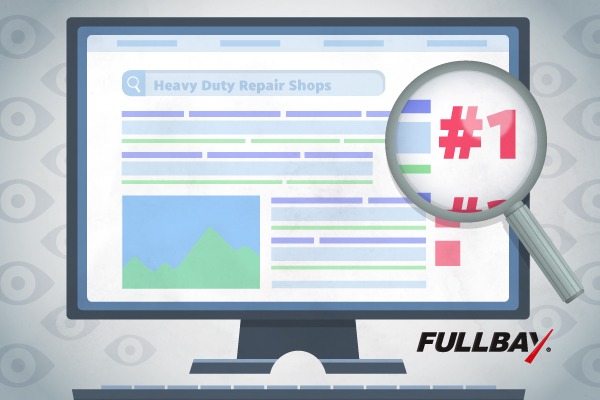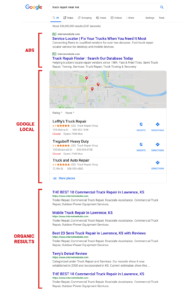How to Get Your Shop Website to Rank #1 on Google

You’ve done it: You’ve created a website for your shop! Now all you’ve got to do is sit back and wait for business to motor in, right?
Well, no. Not exactly.
Unfortunately, your work doesn’t end just because you put a site together. Your website is a big portion of your marketing plan, but it’s not going to do the job by itself. Think of your shop’s site as your truck. Your vehicle is fine on its own, but you still need to put some diesel in it to make it actually go, which in this case equates to being seen by Google. Yes, there’s other search engines out there, but let’s be blunt: Google rules the roost, and other search engines are looking toward it for guidance. When you optimize for Google, you’re optimizing for everyone.

Your website is nothing but deadweight if no one can find it, and the easiest way to ensure someone finds it is to make sure Google puts it on the first page of search results. The coveted #1 spot on Google is how you can absolutely ensure your shop gets in front of a lot of eyes.
So how do you do that?
We’re glad you asked!
We’ve put together this guide to show you how to get your shop website to rank #1 on Google, though we want to caution you that this isn’t a guarantee. You can do everything right, but if your immediate competition does it better, well, they’re going to get that spot. Beyond that, there are hundreds of factors that go into determining how a site ranks — and a lot of those factors Google keeps close to the vest. Aiming for that #1 spot always involves playing a bit of a guessing game, but the tips we provide here generally work well.
Ready to ramp up your search game? Here we go.
Part 1: Google and How it Works
To understand what sort of work you need to do to get your shop to the #1 spot, you need to understand a bit about how the Google search monster works when someone is looking for your shop. In the case of a service-based site, something called Local Search is your best friend.
As an example, let’s look at what happens when someone types in “truck repair near me.” Arizona-based SEO expert Aaron Treguboff explains:
“If you have your location tracking turned on, Google is going to check it, and then it will search for the shops near you. It starts to order those shops by reviews, local citations (people who are linking to them who are also local), backlinks to the website, and things like user experience.”
That’s the backbone of a “near me” search, though Aaron cautions that there’s a lot of other factors that play into a site’s ranking.
Now that you know a bit about how the back end works, let’s get into how to get your shop into play.
The overall process of getting your site to rank on Google — both overall and in the “near me” searches — is called Search Engine Optimization, better known as SEO. This means priming your site for Google to look at and rank. There are several moving parts to this that you can adjust on your own, essentially giving your site its best chance at ranking on Google. We’ll go into them in more detail below, but they include relevant content, perceived authority, and keywords that Google can identify as relevant to your business.
You’re basically creating a cocktail and sliding it down the bar. If Google finds it to its liking, it will display your shop’s site when someone near you is searching for your services. If it doesn’t, then it will let that drink slide right on by — past paying customers.
Part 2: Getting Your Shop in Order
Now that you have some context about how Google works, you’re ready to start adding the ingredients to make your site rank.
Your Site
Google likes content. It likes content so much, it’s likely to push your site closer to the top of its rankings if you update frequently.
There’s a lot of discussion around how often Google crawls (layman’s term for “notices”) a site. When your shop site first goes live, Google will eventually index it, which is what makes it appear in search results. We turned to Aaron again to find out his opinion on how often active sites get noticed, and he said, “I usually tell people [who own smaller sites] that Google will look at their site once every few days.”
Here’s some of the content Google notices on its sweeps:
- Your name, address, and phone number (you’ve seen this as NAP) need to be current Make sure they’re up to date on your site and anywhere your shop may have a presence, like Facebook or Yelp.
- A clean, attractive website that displays on big screens, small screens, and mobile screens. As we noted in our post about building a website, a lot of folks will be searching for a shop on their phone. You don’t want to miss them!
- Post reviews and testimonials from real customers. Yes, Yelp has this at least partially covered, but praise and thanks on a website are an easy way to sway potential customers.
- Blog posts, articles, or coupons that are updated on a regular basis. This is where you can really help your site get noticed during Google’s crawls, particularly if you’re providing content that is truly useful to your audience. Here Aaron cautions moderation. “Be consistent and realistic for content,” he says. “A lot of people try to do too much and can’t manage it. I like to tell people to start with one blog post a month, and make sure it comes out at the same time each month.” In other words, don’t create an overly ambitious calendar of 30 long blog posts a month when you’re brand-new to blogging; that’s a quick road to burnout. You also need to ensure that your content is different from what everyone else is putting up. “Don’t write about how to change a tire if you’re going to give the same advice as everyone else!” By the way, fresh content is a double reward. Not only does Google notice you more, but creating useful content prompts visitors to share that content. And Google loves links.
- Pages with correct titles: Aaron says if he could give one tip to every shop owner, it would be this. “Make sure you think carefully about titles. Don’t just use the defaults that come with a lot of sites — use titles that describe your shop and where you are. If you are a heavy duty shop in Phoenix, don’t make your homepage title for Google be: ‘Home | Shop Name.’ Instead, make sure it is ‘Heavy-Duty Repair Shop in Phoenix, Arizona | Shop Name.’”
Your Social Media
No, Google isn’t reading your Facebook or Twitter (or so they say), but maintaining active social media accounts goes a long way in boosting your site’s visibility. When you share something on your site, people look at it. Google may not be reading every word of your social media, but it is noticing all those people and sites passing around your blog posts, coupons, and tips. If you’re getting a lot of links shared, then your site is building authority, which also helps improve your Google ranking.
If you’re curious about how social media and Google play together, this Hootsuite article offers a more in-depth approach.
Google Business Profile
Google actually wants to help your shop get noticed. Not because it particularly wants you to succeed or fail, but because pointing people toward products and services that make them happy works in its best interest. If Google recommends your shop, and customers visit you and like you, then they’ll trust Google’s recommendations and go back for more.
An easy way to further this winning partnership is through Google Business Profile, which lets you create a snapshot of your shopfront that Google can shop around to customers looking for heavy-duty repair shops.
When you search for a business name on Google and it appears in a box on the right-side of your screen with information like shop hours, phone number, reviews, and its position on the map, that’s entirely due to Google Business Profile. People searching for a repair shop on their phones may even come across a Google Business Profile result before looking at the top-ranked pages, so you definitely want to get in there. Today’s Local Media describes some elements that automotive shops should consider when updating their profile, many of which are applicable to heavy-duty repair shops.
To fully control it, you’ll have to create a profile or find an existing profile (if your shop has been around for a while, it’s likely a profile already exists) This is another place where you can update your NAP, as well as your shop’s hours. You can also upload photos of your shop, your waiting area, and any certifications you or your techs may have.
Part 3: Local SEO and How it Works
Local SEO is the best friend you’ve got when it comes to getting your shop ranked #1 on Google. 
In the last few years, keywords with add-ons like “near me” have increased in usage. A report by Hedges & Company covers its steady rise in this article (which is geared toward the automotive industry but remains applicable in other fields). In short, adding “near me” to any search string signals intent to Google.
If you search for “diesel gas,” you will come up with all kinds of information about diesel gas — which is great, if that’s what you’re looking for. Google treats that sort of query as fact-finding. If you modify that phrase to “diesel gas near me,” then Google decides you’re probably looking to fill up the tank on your diesel truck. It will zero in on your location and show you some diesel gas stations within a limited radius.
You want to appear in people’s “near me” searches.
Since your shop is in a fixed location, you want to attract/make yourself known to potential customers in the surrounding area. By setting up your GMB and making sure your NAP is consistent across your site and social media, you’re signaling your exact location to Google, which in turn can project it out to your best customers.
BrightLocal has an excellent breakdown of just how to make use of local SEO here, but the easiest way for you to control it is to make use of Google Business Profile. If you’ve got it set up correctly, your shop will appear when someone near you is searching for “heavy-duty repair near me.”
Does all this sound exasperating or time-consuming? Digital marketing can open new doors for your business, but it’s also got a learning curve. If handling it on your own seems like a tall order right now, hand it off to the heavy-duty marketing experts at Dieselmatic. They’re part of the Fullbay family, so you know you’re going to get attentive service and quality results—but they also know exactly what the diesel industry needs in terms of digital marketing. You can trust them to handle your website design, social media, GMB, and more.
You’ve put your blood, sweat, and tears into your shop — you’ve worked too hard not to give yourself every effort to succeed. A functioning website and good SEO tactics go a long way in making your shop website rank high on Google, and that high rank — that visibility — can be the difference between a trickle of customers and the steady business you need for success.

